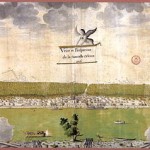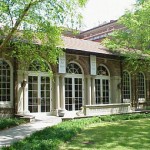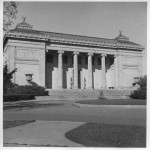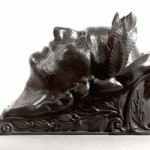 The earliest known painter who worked in New Orleans was Jean Pierre Lassus, the surveyor-painter. But he did not remain long in the colony. His Veue et Perspective de la Nouvelle Orleans, painted in 1726, hangs on the walls of the French National Archives in Paris. Any portraits or scenes of New Orleans painted in the French regime would have been destroyed in the great fires of 1788 and 1794 because the next earliest painter we know about is Francisco Salazar. Salazar probably painted the portrait of Don Andres Almonester y Roxas and others, especially that of the Montegut family. In 1803, J. L. Bouqueto de Woiseri painted his View of New Orleans from the Plantation of Marigny. French artists Felix Achille Beaupoil de Saint-Aulaire and Charles Alexandre Le Sueur have left us several interesting mementos of their stay here in the 1820s and 1830s.
The earliest known painter who worked in New Orleans was Jean Pierre Lassus, the surveyor-painter. But he did not remain long in the colony. His Veue et Perspective de la Nouvelle Orleans, painted in 1726, hangs on the walls of the French National Archives in Paris. Any portraits or scenes of New Orleans painted in the French regime would have been destroyed in the great fires of 1788 and 1794 because the next earliest painter we know about is Francisco Salazar. Salazar probably painted the portrait of Don Andres Almonester y Roxas and others, especially that of the Montegut family. In 1803, J. L. Bouqueto de Woiseri painted his View of New Orleans from the Plantation of Marigny. French artists Felix Achille Beaupoil de Saint-Aulaire and Charles Alexandre Le Sueur have left us several interesting mementos of their stay here in the 1820s and 1830s.
In the 1830s the growing wealth and culture of New Orleans attracted a number of painters, mostly portraitists. One of the best known was the well trained Frenchman Jean Joseph Vaudechamp, who painted in the style of Ingres. Vaudechamp painted the leading citizens and their wives, and many of his portraits are in the Louisiana State Museum’ and in private collections. Two visiting Frenchmen painted memorable New Orleans pictures. One was Hippolyte Sebron, who painted the-best-known steamboat picture, Giant Steamboats at New Orleans and the famed impressionist Edgar Degas, whose Cotton Market of New Orleans is one of the prized possessions of the Museum of Pau, France.
 In the 1880s there was an art revival in New Orleans. The Southern Art Association was formed in 1883 and soon had a membership of five hundred. In 1887, Ellsworth Woodward, himself a painter of no mean ability, founded the art department of Newcomb College. The Newcomb Art School flourished, and in 1897 Ellsworth and his brother William added and in 1897 EIlsworth and his brother William added a pottery department, which in the next two decades the Arts and Crafts School, 712 Royal Street, was founded, and for a number of years trained many artists. Courtesy French National Archives
In the 1880s there was an art revival in New Orleans. The Southern Art Association was formed in 1883 and soon had a membership of five hundred. In 1887, Ellsworth Woodward, himself a painter of no mean ability, founded the art department of Newcomb College. The Newcomb Art School flourished, and in 1897 Ellsworth and his brother William added and in 1897 EIlsworth and his brother William added a pottery department, which in the next two decades the Arts and Crafts School, 712 Royal Street, was founded, and for a number of years trained many artists. Courtesy French National Archives
The Isaac Delgado Museum of Art, opened in 1911, became the repository of several New Orleans collections-the Hyams Barbizon and Salon paintings, the Morgan Whitney jades, and the Howard collection of Greek pottery. WPA workers are seen here at the museum during the 1930s. Courtesy New Orleans Public Library
 A handsome Greek Revival building locate in City Park, the museum for years was a kind of art mausoleum, and it was not until the arrival of its first professional director, Alonzo Lansford in 1948, that the institution took on new life. He and Arthur Feitel, the president of the Delgado board, secured thirty two Italian Renaissance paintings of the Kress collection, and paintings of modern schools began to appear on its (1958-1961), and its present director, James B. Byrnes, who came in 1962 under a completely reorganized Isaac Delgado Museum of Art Association, have done wonders in scheduling shows and in the acquisition of important works of art through purchase or gifts. In 1970, three large wings were started to more than double the size of the museum and provide a much-needed auditorium. This is how the expanded Isaac Delgado Museum of Art will look. Courtesy Isaac Delgado Museum of Art
A handsome Greek Revival building locate in City Park, the museum for years was a kind of art mausoleum, and it was not until the arrival of its first professional director, Alonzo Lansford in 1948, that the institution took on new life. He and Arthur Feitel, the president of the Delgado board, secured thirty two Italian Renaissance paintings of the Kress collection, and paintings of modern schools began to appear on its (1958-1961), and its present director, James B. Byrnes, who came in 1962 under a completely reorganized Isaac Delgado Museum of Art Association, have done wonders in scheduling shows and in the acquisition of important works of art through purchase or gifts. In 1970, three large wings were started to more than double the size of the museum and provide a much-needed auditorium. This is how the expanded Isaac Delgado Museum of Art will look. Courtesy Isaac Delgado Museum of Art
 One of the most fascinating objects in the collection of the Louisiana State Museum at the Cabildo is the death mask of Emperor Napoleon Bonaparte. It Was made by Francisco Antommarchi, who had attended the emperor in St. Helena when he died. Courtesy Louisiana State Museum
One of the most fascinating objects in the collection of the Louisiana State Museum at the Cabildo is the death mask of Emperor Napoleon Bonaparte. It Was made by Francisco Antommarchi, who had attended the emperor in St. Helena when he died. Courtesy Louisiana State Museum
The University of New Orleans Ogden Museum of Southern Art is currently home to the largest and most comprehensive collection of Southern art in the world. Located in the Warehouse District today next door to the WWII Museum. To learn more about the Ogden Museum of Southern Art read the Hotel Monteleone’s review.
